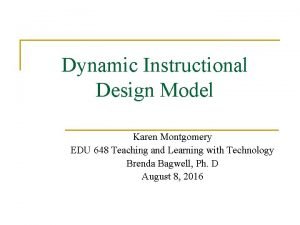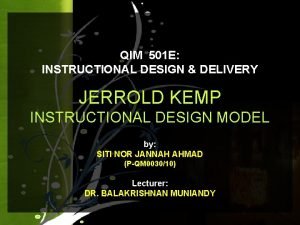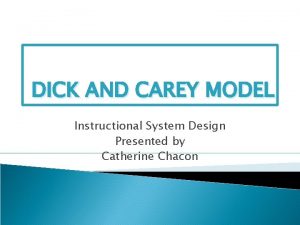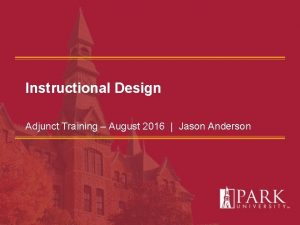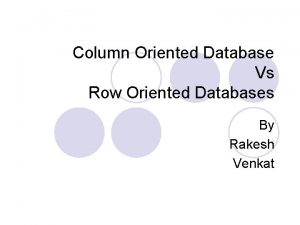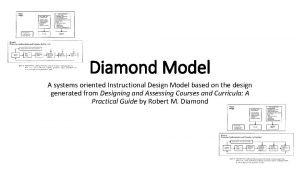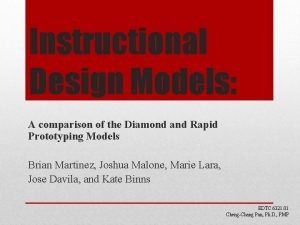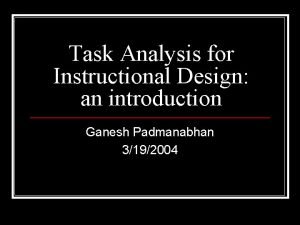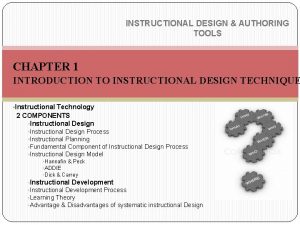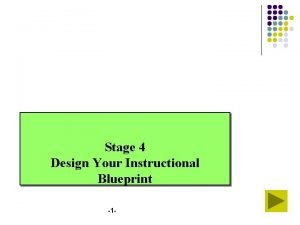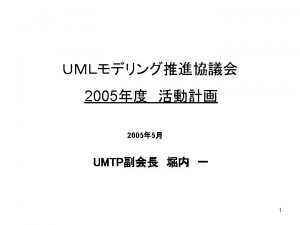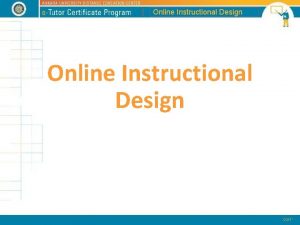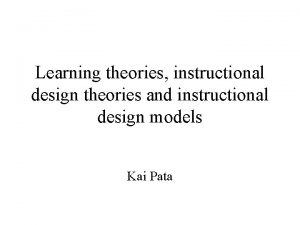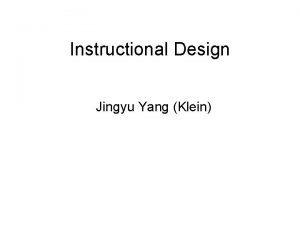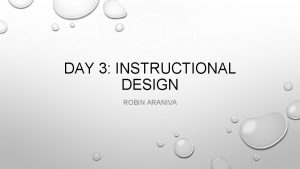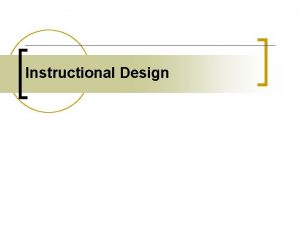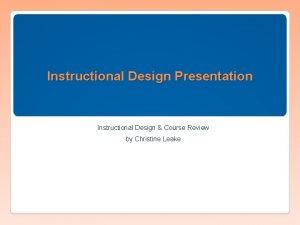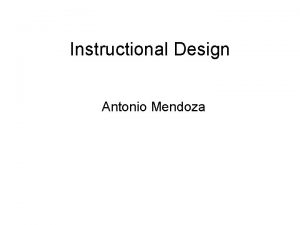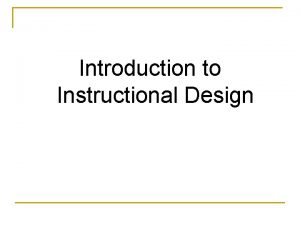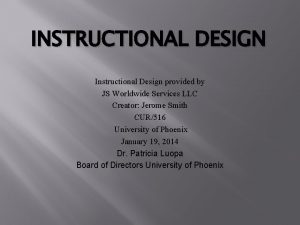Diamond Model A systems oriented Instructional Design Model















- Slides: 15

Diamond Model A systems oriented Instructional Design Model based on the design generated from Designing and Assessing Courses and Curricula: A Practical Guide by Robert M. Diamond

The Instructional Design Model

The Instructional Design Model

Diamond Model • Considered by Gustafson & Branch to be a Systems Oriented Model. “Systems oriented models typically assume that a large amount of instruction, such as an entire course or entire curriculum, will be developed and that substantial resources will be available to a team of highly trained developers…. original development is specified…. technological sophistication of the delivery system vary. ” • Systemic approaches allows the instructional designer to preview and plan every aspect of lesson plans to make for successful learning.

Diamond Model & the Two Phases of Design 1) Phase One: Project Selection & Design: Ø The feasibility and desirability of the project launch are examined. Ø Establish needs, insuring success. Ø The “ideal” selection of the project is made based on: Basic-Planning inputs that are project-specific; these are: • Domain of knowledge • Student knowledge, attitudes and priorities • Social needs • Research • Educational priorities

Diamond Model & the Two Phases of Design 2) Phase Two: Project Production, Implementation & Evaluation: Ø Development of each unit includes a seven-step process: • Determining objectives: • Design of evaluation instruments and procedures • Selection of instructional format and examining existing materials • Producing new materials or modification of materials • Coordinating logistics for implementation • Full scale implementation • Evaluation & revision

Instructional Design Elements The Diamond Model is a learning system that is more comprehensive than most, which works towards an “ideal” design utilizing flow diagrams to show content and structure and uses quality information. It was specifically designed for courses and curricula in higher education. All learning systems include an ADDIE model: Analyze/Analysis Develop/Development Design Implement/Implementation Evaluate/Evaluation

5 Key Characteristics of the Diamond Model According to the author, Robert M. Diamond: “In addition to its simplicity, the model has five other characteristics that, when combined, differentiate it from most others. 1) Forces those using it to think in “ideal” terms. 2) Encourages the use of diagrams to show structure and content. 3) Relies heavily on the use of data. 4) Encourages a team approach. 5) Is politically sensitive. ”

3 Central Features of the Diamond Model 1) Emphasis is placed on matching the decision on whether to engage in instructional development to – Institutional as well as Instructional issues. 2) Emphasis is placed on the assurance of faculty ownership of the instructional development. 3) Emphasis is placed on the need formal organizational support.

5 Key Stages of the Diamond Model Diamond’s model for developing a learner-centered curriculum or course consists of five stages: 1) Determining the need to change; 2) Identifying goals or desirable outcomes; 3) Designing the curriculum or instruction to attain these goals and the assessments that will provide the necessary feedback as to the attainment of goals; 4) Implementation and assessment (which feeds back to the goals statement); and 5) Revision based on the results of the assessment.

Benefits of the Diamond Model • The model is easy to use, sequential, and cost-effective; it will save you both time and effort by significantly reducing the time needed for implementation. • It can be used for the design or redesign of courses, curricula, workshops, and seminars in every subject area and in every instructional setting_ traditional and nontraditional. • The programs you develop will meet accreditation agencies’ demands for clear statements of learning outcomes with an associated high-quality student assessment process. • It is politically sensitive, protecting you from decisions by others that could jeopardize implementation. • It will ensure that all important questions are asked and all options are explored before key decisions are made. According to the author; Robert M. Diamond, from “A Brief Introduction to the Model. ”

Challenges of Curriculum & Course Design • Robert Diamond addresses faculty in the majority of his textbook, stating “This book is designed to help you go through the design, implementation, and evaluation processes. It will provide you with a practical, step-by-step approach supported by case studies, a review of the significant literature, and introduces you to materials that you should find extremely useful. ” • He asks the reader to think of: • Specific goals for the student • Demands of accreditation • How the teacher can facilitate learning From Goals to Outcomes to Assessment

Advantages of the Diamond Model • “The design can be utilized for course and/or curriculum design. • The design forces the developer to think “outside of the box”. • The model identifies key factors that should be thought of in sequential order. • It serves as a procedural (type) guide. • The model allows you to understand you are in a process, and for others to know their individual roles • Improves efficiency by reducing duplication of effort and ensuring that critical questions are asked as well as alternative solutions explored. • It is data driven. ”

Perceived Disadvantages of the Diamond Model • Very linear • Constraining, limits creativity • Time-consuming to implement • Specific to higher education • Classroom oriented • Directed at total curricula in addition to individual classes • Requires significant input from university personnel (as well as other academic departments)

References Branch, R. M. (2009). Instructional design: the addie approach. New York: Springer. Branch, R. M. , & Gustafson, K. L. U. S. Department of Education, Office of Educational Research and Improvement. (1997). Survey of instructional development models (IR-103). Syracuse, New York: ERIC Clearinghouse on Information & Technology.
 Object-oriented systems analysis and design using uml
Object-oriented systems analysis and design using uml Dynamic instructional design model
Dynamic instructional design model Why is assure model important in teaching and learning
Why is assure model important in teaching and learning Qim far lab
Qim far lab Dick and carey
Dick and carey Arcs instructional design
Arcs instructional design Sam instructional design model
Sam instructional design model Kemp's instructional design model
Kemp's instructional design model Trade-oriented sales promotion
Trade-oriented sales promotion What is a column row db
What is a column row db Robert diamond systematic design model
Robert diamond systematic design model Diamond model of curriculum development
Diamond model of curriculum development Task analysis instructional design
Task analysis instructional design Instructional design authoring tools
Instructional design authoring tools Concept of teaching
Concept of teaching Gagne-briggs model
Gagne-briggs model

